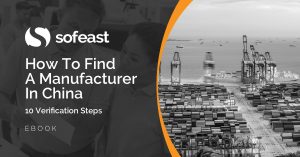A lot of our clients develop their own products, often in the electro-mechanical space. Some start with a bang and have large pre-orders. They are the lucky ones (on the commercial side, at least). Many others have more modest objectives, requiring only low volume manufacturing at first, and can struggle to find an interested manufacturer in China. I thought I’d share some tips for companies in this situation.
Tips for successful low-volume manufacturing in China, for a new electro-mechanical product
Here are my tips to help you source suppliers who will accept lower volumes:
1. Handle the design work on your side
This is a no-brainer for the aesthetic design. Don’t count on Chinese suppliers to do a good job for you here. (Special case: if you really don’t care about the aesthetics, look for an enclosure already existing on the market.)
When it comes to the engineering work (CAD drawings, electronic, firmware…), you will probably have a hard time finding a manufacturer willing to handle that for you.
Face the hard reality. In China or in Vietnam, no OEM manufacturer will invest a lot of engineering & management time in order to get small orders. That’s not their business model. If they do, it is actually suspicious (are they planning to sell the product to their other customers?).
It means you need to either hire your own team (but will it be economically viable?), look for technical resources on Upwork (but you will face challenges if your project is complex: who will make the decisions?), or work with a design house.
2. Confirm that the components can be purchased and assembled at the right cost & quality
The main constraint will probably be the procurement of one or several components. A new product involves some new parts, and that’s where issues frequently come up.
The fancy surface treatment on that metal part might be difficult to get right, and the few really good platers/painters/anodisers are not interested in small batches. In that case, find another approach. Use another alloy and/or another color, go for a more common treatment, etc.
Even if your product is for a B2B use and you can afford to pay much more than consumer product buyers would, this will be hard to handle. You may find it very frustrating. Component suppliers really focus on volume, volume, volume. They don’t try to understand your business and adapt their approach.
3. Wherever possible, go for standard components
As I wrote above, a new product comes with new parts… but there are ways to minimize all that ‘newness’.
For example, if your product has electronic components, going into production based on an Arduino model is probably not optimal if you forecast that a few thousand pieces will be made over the product lifetime.
On the other hand, do you need to design & develop your own PCBA from scratch? Maybe, but maybe not. If you search “PCBA” in AliExpress, you will find a number of already-developed boards for very common applications, and one of them might be a good fit. (That’s not very common, but follow this line of reasoning and you might find another way of re-using something that already exists.)
4. Work with an assembler that itself has no MOQ (Minimum Order Quantity)
The typical Chinese or Vietnamese factory doesn’t like small batches and low volume manufacturing for several reasons:
- Their business model is to make a margin on the products they make. Small quantity tends to mean a low overall margin. (They often don’t even know how to invoice for their services!)
- The salesperson makes a certain percentage on the order. Small order = small commission = low motivation.
- They only want to release relatively large batches on the production floor because their operators are paid by the piece and are reluctant to learn how to make a new product (low efficiency in the first hundreds of pieces) only to change over before they reached high efficiency.
- The boss likes to boast about large customers and volumes and can be ashamed of having accepted a small order.
You need to avoid those companies.
And the good news is, some relatively small factories (typically contract manufacturers) have avoided those pitfalls. No salesperson on commission, no production operators on piece rate, a mixed (service & manufacturing) business model, and an appreciation for doing business with good people.
Those factories will tell you “we have no MOQ, but we’ll be held to the suppliers’ MOQs”. This is why the component selection is so important.
5. Work with an ODM supplier if you need a complex/niche technology
Developing things from scratch makes less sense if your production volume and your overall margin are going to be relatively low. If your product can incorporate a module that was already developed and is offered by an ODM supplier, that’s usually an easy decision!
In many cases, some adjustments will be needed. Still, it will be much faster than doing the work from zero.
If you don’t want that ODM to know what the end-use of the product is (often a very wise consideration), have another factory assemble and pack the whole product together.
Advice for buying off-the-shelf products, or your own textile products, in low volume
Fredrik Gronkvist wrote an insightful guide to importing small volumes. If I summarize it, Fredrik’s advice is as follows:
- You might have to use standard materials/components, accept to increase your order size, or buy a higher quantity of a key material and have the supplier keep it in inventory.
- The factory may not tell you, but they might have to change a key material every time, based on what is available in stock on their local market
- If you cannot buy direct from China, buy from another importer in your country that already buys the same product (they just need to order more pieces). If you can buy direct from China, working with a trading company won’t help much since they generally don’t hold inventory.
- Avoid buying products that are in sensitive categories (for babies/children, electrical, in contact with food…) since you will probably have to pay for laboratory testing and it is not cheap.
- There are ways to brand your product that don’t come with high fixed costs. Other do (e.g. a plastic injection mold with your own logo), so avoid those.
- Think of your business model. You probably won’t be able to compete on price. Go for niche markets, differentiate yourself, etc. In many cases, buying higher-quality products and touting that benefit on your market can work well.
- Be smart about logistics because it can add a lot to your fully-loaded costs.
Your say…
Have you found a Chinese supplier willing to take on your project with low volume manufacturing? What tips can you provide the readers? Did you go through any teething trouble with them?
Are you trying to find a manufacturer in China who is well-suited to your needs and can also deliver on their promises?
Sofeast has developed 10 verification steps to help importers find the right manufacturing partner in China. They’re shared in this FREE eBook: “How To Find A Manufacturer In China: 10 Verification Steps.”
It covers:
- Background checks
- Manufacturing capabilities
- Quality system auditing
- Engineering resources
- Pricing, negotiation, & contracts
- …and much, much more
Just hit the button below to get your copy and put yourself in a great position to get better results from Chinese manufacturers who supply your products:



China is already a leader in the manufacturing sector. These tips are very helpful. I am looking at outsourcing the production of some of the electromechanical products and due to pandemic, it is close to impossible to find a new vendor to take low volumes. Thanks for sharing these tips.